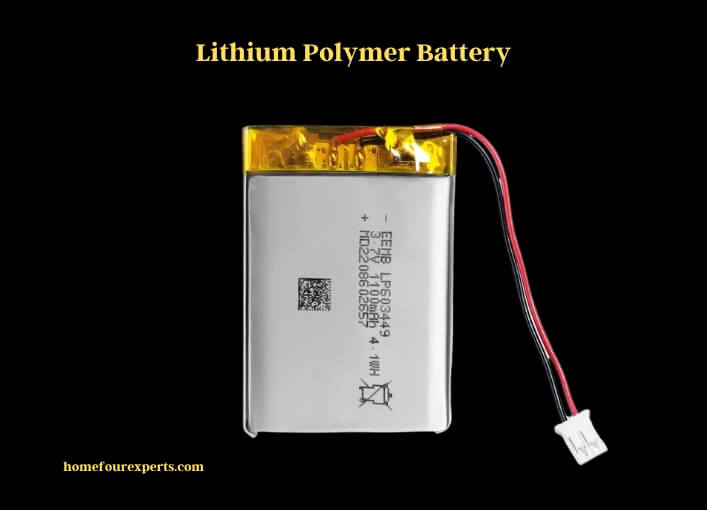Published on: June 7, 2022
Written by Liam Jaxon / Fact-checked by David Rowan
The ability to carry around a gadget is now a requirement for nearly every electronic device on the market. Due to this, a wide variety of battery types have been developed. The most extensively used battery type is lithium polymer batteries. Lithium Polymer batteries have taken their place in portable electronics and cell phones.

Because of the lighter weight, lithium polymer batteries are used as marine lithium batteries. Rather than using liquid electrolytes; this rechargeable battery employs a polymer electrolyte. Because of the wide range of choices, lithium-poly batteries are highly effective and safe to use. Read on to learn more about the many types of lithium polymer batteries, their features, and which one we think is best.
What Is a Lithium-polymer Battery?
Lithium polymer batteries are convenient and found in various shapes and sizes because they are readily available. Lithium-polymer battery technology uses a dry, porous chemical or gel-like electrolyte for positive and negative electrodes.
This type of rechargeable battery contains a lithium-ion battery housed in a soft polymer casing, and the name “lithium-polymer” refers to the type of battery. An electrolyte-gelled polymer electrolyte lithium-ion battery could be another example of this term. However, the name refers to a pouch-style lithium-ion battery is a lithium-ion polymer battery.
A lithium-polymer battery’s softshell makes it lighter and more flexible than a traditional lithium-ion battery. This makes lithium-polymer batteries ideal for use in remote control cars and other electronic equipment.
How Does a Lithium-polymer Battery Work?
There are numerous additional names for lithium-ion polymer (LiPo) batteries, such as “Li-poly,” “lithium-poly,” and “PLiON.” A barrier separates the anode and cathode of a lithium battery while allowing ion passage between the electrodes, and it also contains the electrolyte in a LiPo.
Polymer separators can be used as “shutdown separators,” preventing the battery from overheating during charging or discharging. There must be at least one polyethylene layer and at least one polypropylene layer for the shutdown separator to function properly.
Aside from wafer-thin layers (100m), LiPos also have other components that can be mass-produced cheaply. Metal-free batteries with high energy density and low weight can be made. Achieving huge formats and low cell heights is possible, but mechanical manipulation is necessary. It’s not wise to charge a lithium battery with a normal charger.
Are Lithium Polymer Batteries Safe to Use in Consumer Products
Yes, lithium polymer batteries are safe to use in consumer products as long as they are of a high quality and are used in accordance with the manufacturer’s instructions. They are generally considered to be a safer alternative to lithium-ion batteries, due to the fact that they are more resistant to overheating and the risk of fire is lower.
Special Charging Requirements for Lithium Polymer Batteries
Yes, Lithium Polymer batteries must be charged with a lithium-ion battery charger and should not be overcharged. The battery charger should have an automatic shutoff when the battery is fully charged.
Lithium Polymer Battery Types
Batteries that alter their positive electrode materials in order to attain different energy densities, capacities, and temperature resistance are referred to as distinct sorts of LiPo batteries. LiPo batteries have four basic types of chemistries:
- Lithium-ion manganese oxide battery (LMO, LiMn2O4);
- Lithium-ion ternary battery (NMC, NCA);
- Lithium cobalt oxide battery (LCO, LiCoO2);
- Lithium iron phosphate battery (LiFePO4, LFP).
Lithium-ion Manganese Oxide Battery (LMO, LiMn2O4)
The cathode material in these lithium-ion batteries is LiMn2O4. Capacities range from 90 to 120 mAh/g in reality. A 3–4V working voltage range is recommended. The positive electrode material has a high manganese content, cheap cost, excellent safety, and ease of preparation.
LMO batteries can be discharged at 20-30A and generate mild heat. A 1-second load pulse of up to 50A is also possible. Using this current with a constant high load should keep the battery temperature below 80°C. Everything from power tools to hybrid and electric autos relies on it.
Lithium-ion Ternary Battery (NMC, NCA)
The cathode of the ternary polymer lithium battery is either nickel-cobalt manganate (NiMnCo) or nickel-cobalt lithium aluminate (NCA). Cobalt (Co), manganese (Mn), and aluminum are all examples of ternary composite cathodes (Al). The nickel, cobalt, and manganese ratio can be altered to fulfill precise capacity and magnification requirements.
- 333 code (Ratio: One nickel, one cobalt and one manganese).
- 523 code (Ratio: Five nickel, two cobalt and three manganese).
- 622 code.
- 811 code.
Lithium Cobalt Oxide Battery (LCO, LiCoO2)
The first commercialized lithium cathode material is lithium cobalt oxide. Batteries made on lithium cobalt oxide have a stable structure and good capacity ratio—the 3.7V nominal voltage.
In the construction of the positive electrode, LiCoO2 is employed. The theoretical capacity is 274mAh, and the real capacity is roughly 140mAh. This battery provides high energy, good cycle performance, easy production and processing.
Lithium-iron Phosphate Battery (LiFePO4, LFP)
Lithium iron phosphate is electrochemically active and resistive, and Nanoscale phosphate cathode materials help this. It delivers high-rated current, long cycle life, thermal strength, increased safety, and tolerability. Compared to other technologies, it also has a lower environmental impact. Even yet, there are obvious weaknesses in the system as a whole.
It has low conductivity, taps density, and an energy density of only 120-150wh/kg. Lithium phosphate replaces lead-acid starter batteries. A line of four batteries produces 12.80V (4S), which is the same as six 2V lead-acid batteries.
Features of LiPo Batteries
LiPo batteries are the best in terms of benefits, even in public perception. Below are some features that may attract you-
- The external packaging of the Lipo battery employs aluminum-plastic film and gel electrolyte, making it lighter, safer, and more energy-dense;
- Li-polymer batteries are lighter than conventional batteries; the client favours them;
- Its internal resistance is smaller than a liquid battery at 35 m;
- The Lipo battery’s power can extend many apps’ standby periods;
- The li-polymer battery can be customized to increase or decrease cell thickness;
- The colloidal electrolyte used in Lithium Polymer Batteries is more stable and has a larger discharge platform than the liquid electrolyte;
- It reduced the risk of overcharging and electrolyte leaking.
Our Best Recommended Lithium Polymer Batteries
Like other lithium batteries, lithium polymer batteries have more energy. Several brands of lithium polymer batteries exist. Below I discussed their various benefits and drawbacks.
Gen Ace
Gen Ace is the popular lithium polymer battery brand. People say Gens Ace has the best performance and durability. They come in various sizes and won’t need to be replaced as often as other batteries, and the Dean’s connector is included.
Despite their high cost, they deliver outstanding outcomes. Gens ace 7.4V 450mAh 2S LiPo Battery has 450 mAh suitable for beginners and daily practice. Another high volt 1000 mAh Gens ace 7.4V LiPo Battery performs well in a small quadcopter, FPV, FPV headset, RC Car, etc.
Zippy
Zippy batteries are a great lithium polymer battery brand. They are amazing in terms of price and performance. One of them is the ZIPPY Compact 1000mAh 3S 35C LiPo battery that offers excellent performance and delivers full capacity & discharge. The Zippy Compact 4000mAh 2S 25C Lipo Pack also provides good performance. New buyers or crafters might choose zippy batteries.
Turnigy
Turnigy batteries function and last virtually as well as Gens Ace. But, like Gens Ace, it has a short life. Above all, the batteries are fantastic, especially for the price. The Turnigy 1000mAh 2S 20C LiPoly battery includes heavy-duty discharge that leads to reduced resistance and supports high current loads.
There are gold-plated connectors on the Turnigy 1800mAh 3S 20C Lipo Pack and JST-XH type balance connectors. This brand is nice because it is less expensive and includes everything.
Thunder Power
If you’re looking for an excellent lipo battery, go no further than Thunder power. Competition in remote-controlled racing has this at the top of its agenda. In spite of this, it’s not the most long-lasting option.
EEMB
EEMB is a lipo batteries brand that offers no leaks, low cost, and high cycle life. Among various LiPo batteries, the EEMB 3.7V Li-ion 502030 Battery performs best. Another EEMB 3.7V 1100mAh 603449 Battery keeps the cells 40%-60% charged for long-term storage. We suggest charging the battery every three months and storing it in a cool, dry location with a voltage between 3.7 and 4.0 volts.
The Difference Between Lithium-ion and Lithium Polymer Batteries
While both lithium-ion and lithium-polymer batteries have benefits and drawbacks, you can choose lithium-polymer batteries if you want a powerful battery without a long delivery time, but not like a 40-volt lithium battery.
Lithium-polymer batteries have less storage space but can produce enough power. If you require power for a long time, you can use lithium-ion batteries, which hold a charge and run for a long time. In the following table, you can find a detailed comparison between Lithium-ion vs lithium polymer.
| Ascribe | Lithium-Ion | Lithium Polymer |
| Voltage | Nominal 3.6 to 3.7 | Same |
| The possible voltage range | 3.0 to 4.35 | Same |
| Temperature Range | -20 to 60 degree Celcius | -20 to 70 degree Celcius |
| Storage Temperature | -20 to 35 degree Celcius | -20 to 35 degree Celcius |
| Capacity Delivery at – 20Degree Celcius | 55 to 65% | 80% |
| Cycle Life | 500 cycles | 500 cycles |
| Charge Temperature | 0 to 40 degree Celcius | 0 to 40 degree Celcius |
| Energy Density |
FAQs
1. Are Lithium-polymer Batteries Good?
These batteries are more rigid and lighter, and these gel-like batteries are less prone to leakage. But the memory effect is inevitable, as the gel-like substance hardens over time, reducing longevity. So there are benefits and drawbacks.
2. What Components Make Up a Lithium-polymer Battery?
A solid polymer is used as the electrolyte and lithium as an electrode for a real LiPo battery, making it a rechargeable Lithium-polymer battery.
3. How Long Do Li-Polymer Batteries Last?
These polymers last between 300 and 500 charge cycles (full to empty) before needing replacement. But you can help extend battery life by charging early.
4. Which Is Better, Lithium-ion or Lithium-polymer Battery?
When it comes to powering large machinery, you can’t go wrong with lithium-ion or lithium-polymer batteries. However, lithium-ion batteries are superior to lithium-polymer batteries, and because they have more power, they are suitable for mass usage.
Final Verdict
It is fair to assume that lithium polymer batteries (LiPo) are the future. Every wise consumer should be aware of their types and features before making a purchase decision. I hope I can make you knowledgeable enough to make your next purchase smooth and confident.
Prior to purchasing any LiPo battery, make sure that it comes with a sufficient power supply cord, good converter, and invest in fireproof bags to avoid any hazardous charging turns.
Relevant Resources:
About This Writer

Hi, I am responsible for the 'Homeowners Power Solutions' category. My name is Liam Jaxon and a licensed technician with 7 years of experience in vehicle batteries, electrical gadgets, and home appliances. My working experience in different residential & light commercial electrical sectors and the automobile industry helped to acquire vast knowledge in this industry.